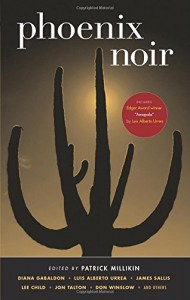If you’re still in the market for stocking-stuffers, and have people on your list who prefer mystery to dragons… <g>. PHOENIX NOIR is a brand-new paperback anthology of short crime stories set in—as one might suppose—Phoenix. I wrote one of the stories, titled “Dirty Scottsdale;” this one is a solo effort by me.
“Dirty Scottsdale” is also the debut in print of Tom Kolodzi, who’s the protagonist of the contemporary crime novel I’ve been working on for some time (in and amongst other things), which I hope to finish sometime next year (along with THE SCOTTISH PRISONER and the second volume of THE OUTLANDISH COMPANION). As you can tell, Tom’s got a voice of his own.
Excerpt from “Dirty Scottsdale” in PHOENIX NOIR (edited by Patrick Millikin):
 It was high noon, and 110. The cops were in shirt-sleeves, the home-owner was wearing plaid bermuda shorts and a wtf? expression. The body floating face-down in the swimming-pool was wearing a navy blue wool suit, which was odder than the veil of blood hanging like shark-bait in the water.
It was high noon, and 110. The cops were in shirt-sleeves, the home-owner was wearing plaid bermuda shorts and a wtf? expression. The body floating face-down in the swimming-pool was wearing a navy blue wool suit, which was odder than the veil of blood hanging like shark-bait in the water.
The girl by the pool was more appropriately dressed—if you could use that word to describe the triangles of turquoise fabric that covered her nominally private parts.
“The poor dope,” I said, shaking my head. “He always wanted a pool. Well, in the end he got himself a pool—only the price turned out to be a little high.”
The girl looked at me. She had a hot-pink towel clutched dramatically to her mouth, eyes wide above it. Turquoise eye-shadow, to match her suit, and a lot of waterproof mascara.
“Tom Kolodzi,” I said, with a jerk of the head toward the uniformed cops. “I’m with the police.” You notice I didn’t say I was the police. “You know the guy in the pool?”
Her eyes got wider, and she shook her head. I took out my notebook and flipped it open, turning to shield it from the cops.
“Your name?”
She blinked, and lowered the towel. Her mouth was blurred with red, and she looked like a little kid who’d been eating a popsicle, breast implants notwithstanding.
“Chloe Eastwood.”
“Any relation to Clint?” I smiled, friendly.
“Who?”
I should have flipped a coin and said “Call it, friendo.” Instead, I asked, “Do you live here?”
She nodded like a bobble-head doll, her eyes going back to the body. “I just… I just came out to tan, and… there he was.”
“You called it in?”
She shook her head, blonde ponytail swishing over baby-oiled shoulders.
“I screamed and Cooney came running out, and the yard-guys and everybody.” She waved vaguely toward the house, where three nervous-looking Mexicans were clustered. A Mexican woman, too, with a blond boy of five or six clutching her leg. “I guess Cooney called.”
Her eyes went to the homeowner: Mr. Bermuda Shorts, shoulders hunched in aggression. One of the uniforms caught sight of me and opened his mouth to order me out. The two uniforms exchanged a quick look, though, then looked right through me before turning deliberately toward the pool.
I relaxed a little. I’d been doing a ride-along—you always want to get acquainted with the cops in a new place—when the 410 call came through. They’d told me to stay in the car, of course, but didn’t lock me in. It could get up to 140 in a parked car, and they didn’t want to explain a dead reporter in the back seat. They didn’t want to explain a live reporter in their crime scene, either; if I kept my mouth shut, they’d pretend they had no idea how I got there, and leave it to Homicide to throw me out.
Now, the Poisoned Pen definitely does have signed copies of PHOENIX NOIR in stock; I know, because I signed a bunch of them a week ago.
Ordering Signed PHOENIX NOIR From the Pen
To order a printed copy of this book signed by me from the Poisoned Pen bookstore, go to:
and enter "Phoenix Noir" in the Search box.
You may also order it in the usual way from your local independent bookstore or through the usual online sources.
Ordering information and formatting on this blog post was updated on January 2, 2017 at 4:00 a.m. (PT) by Diana’s Webmistress.
.jpg)
.jpg)
.jpg)
.jpg)
.jpg)
.jpg)